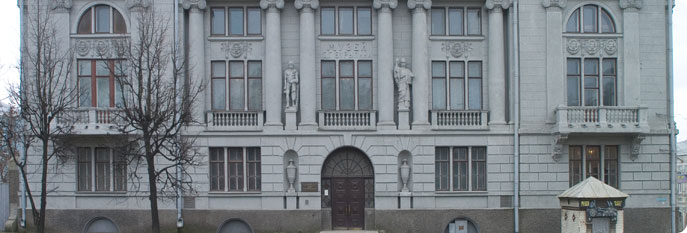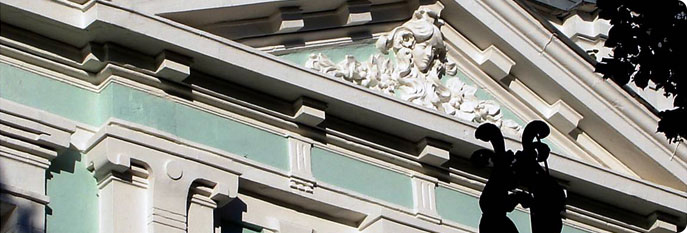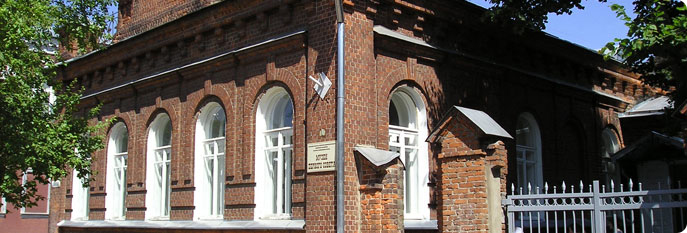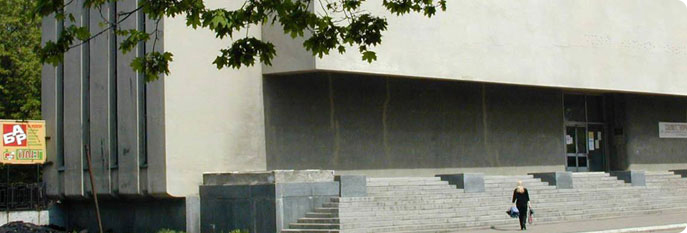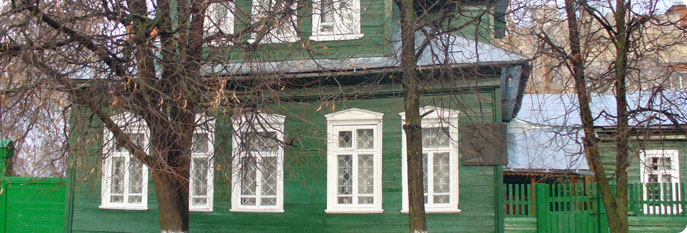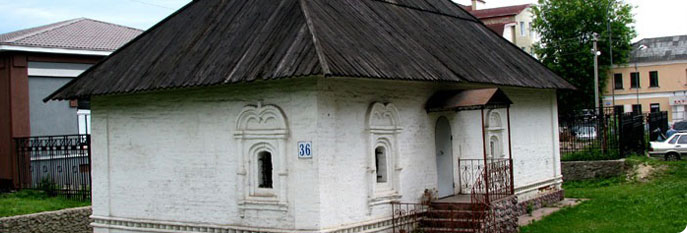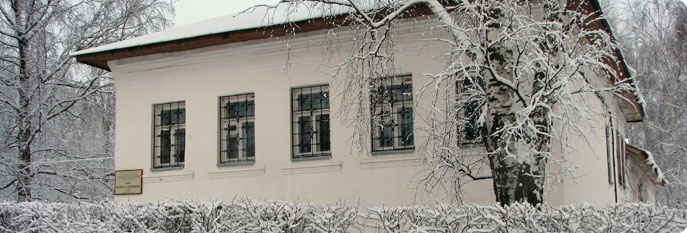History of the Museum
In the early 20th century the Museum of Industry and Art in Ivanovo-Voznesensk was considered one of the best museums of provincial Russia. It was founded byan Ivanovo-Voznesensk manufacturer, collector, Maecenas and enlightener Dmitry Gennadievich Burilin.
The time when the collections had been formed and the unique museum had been created, the late 19th – the early 20th centuries, was marked by the spirit of the European idea of enlightenment. Dmitry Burilin was the representative of that epoch with all the diversity of his collection – from ethnographic items to the works of art, from Antiquity to Modernity. He aspired to open the whole world for the citizens of his home town. Creating his museum, Burilin tried to bring all the richness of the world culture nearer to Russian province.
The “rarities and antiquities” collection originates from the collection of old books, published before the 18th century, and ancient coins which had been formed by his grandfather DiodorAndreevich Burilin.
Diodor Burilin called his collections “treasures” and kept them in a special room of his house. His grandson Dmitry interestedly examined them and listened to the stories of his grandfather about the collected things. But Diodor’s collections were not exhibited publicly, and only close relatives could see them. The grandmother, EudokiyaMikhailovna, having noticed the grandson’s interest in collecting, after her husband’s tragic death in 1860, passed all the antiquities to Dmitry in 1864.
Dmitry Gennadievich significantly enriched the collection of his grandfather’s “treasures”. In 1885 the numismatic collection of a 33-year-old Dmitry Burilin numbered about 100 000 16th – 19th century coins, orders and medals from 236 countries and towns. Great numbers of books, ancient and rare things were kept on the basement floor of the family house.
In that period Dmitry Burilin realized that his collection had outgrown the house and decided to open his “rarities and antiquities” for the public. The unique Burilin’s collection became famous in Russia prior to the opening of the museum in 1914. Dmitry Burilin exhibited his collections not only in his home town, but also in other Russian cities and abroad. For the first time his collections were demonstrated on the exhibitions in Moscow in 1887 – 1888, organized by the Imperial Russian History Museum and Anthropological Museum of Moscow University. Later Dmitry Burilin participated with his collections in the Central Asian exhibition in Moscow in 1891 and Chicago Columbian Exposition in 1893. In 1896 Burilin presented ancient Ivanovo printed fabrics on the All-Russian exhibition in Nizhny Novgorod. The items attracted the attention of the Emperor Nicholas II.
In Ivanovo-Voznesensk Dmitry Burilin’s collections had been exhibited several times; the most significant exhibitions were organized in 1903, 1905, 1908 and 1912. Some of them showed the collection in general, others were devoted to particular collections, e.g. weapons or numismatics.
One of the most significant expositions was held in April 1903. It was arranged in the building of Ivanovo-Voznesensk Women’s Professional School on PokrovskayaStreet (now – ul. 10 Avgusta). The exhibition demonstrated various items – from antique things to household articles of the peoples of the world. The collection of masonic signs and books numbered more than 200 items. The “Russian Department” demonstrated a large collection of printed cottonsand the gold medal diploma for the collection of printed cottons and masonic signs from the exhibition in St Petersburg.
In spring 1905 the exposition of “rarities and antiquities” was organized in Burilin’s house (now it is the building of The Museum of Ivanovo Printed Cottons). Like the previous one, that was also a charitable exhibition. The money was spent on the support for the families of the victims of the Russo-Japanese war of 1904 – 1905.
In 1908 Dmitry Burilin gave his collection of weapons to be exhibited during the celebrations of the tenth anniversary of Ivanovo-Voznesensk Hunting Society. In spring 1912 Ivanovo-Voznesensk women’s professional school building hosted a new exhibition of Burilin’s collections. It was also organized for a charitable purpose – struggle against consumption, the professional textile workers’ disease. The exhibition gained about 1,5 thousand rubles for charity.
In 1912 the Burilins celebrated a centenary of the family’s industrial and public activities. Dmitry Burilin decided to start constructing a special building for the museum. The Town Duma and Council allowed construction of the museum and the underground tunnel on the land of NikolayGennadievich and Dmitry GennadievichBurulins.
On August 25, 1912 the special building was laid. The building had been constructed according to the project of the architect Pavel Trubnikov. The construction had been carried out in very tense financial conditions. Dmitry’s brother Nikolay insisted on the postponement of construction for at least one year due to very bad commercial affairs; not all the materials of construction had been prepared.
Though the construction had been still in progress, in October 1914 the museum opened for organized visitors. Some rooms were leased to Ivanovo-Voznesensk drawing school. Dmitry Burilin was an honorary warden of the school and hoped that the students would use the items of his collection for their education.
The Museum officially opened on December 26, 1914. The draft charter of the museum read that its goal was “to assist the development of local industry through familiarizing with the collection of items of print works, from the initial printed clothes to the newest foods, both of local and foreign production, study of scientific and practical information in print works; to be devoted to art and to take care of preservation and replenishment of the collection of items of Russian and foreign artistic antiquities and the newest artistic items, and to promote love of art among people by means of dissemination of information about it and its aims”.
In the new building Burilin organized a book depository, departments of Greek, Roman, and Egyptian antiquities, rarities from the Far East, antique items of Russian household, a manufacture department, and a picture gallery. In one of the best halls he organized a library and a reading room supported with his and his wife’s funds.
Burilin understood quite well that the unique museum collections needed to be studied, systematized and inventoried in detail. Meanwhile, from 1892 till 1914 there was only one permanent worker at the museum – the book custodian N.I Tarabukin, who died at the war in 1915. Thus, Burilin decided to invite specialists to study and inventory the pieces. Unfortunately, the majority of museum items hadn’t been studied during Burilin’s lifetime.
Dmitry Burilin had always concerned about the future of the collection. In his will in 1896 he wrote: “The collection mentioned should afterwards become the property of our home town Ivanovo-Voznesensk and should never be sold out or plundered (it had been collected in need and with a lot of effort).
The events of 1917 and the revolution changed everything.
After nationalization of the Museum of Industry and Art in 1919 the purpose of its exhibition activities was cardinally changed. The exhibitions of the collection museum were closed. The Museum was granted a status of the museum of local history, and many Burilin’s collections fell into oblivion or were expropriated by the government.
Only several decades later Dmitry Burilin, his personality, contribution to Ivanovo culture, and the uniqueness of his collections were estimated at their true worth.
In February 1993 the established Ivanovo State Alliance of Museums of Local History was named after Dmitry Burilin. The concept created in 2003 gave the opportunity to expose the masterpieces from Burilin’s collections in the Museum’s halls. Since 2003 the exposition of the collection museum has been opened; it includes the exhibitions: “The European Collection”, “The Arsenal”, “The Gold Stowage”, “Art and Time” (“Russian Department”), and the library of Dmitry Burilin.
